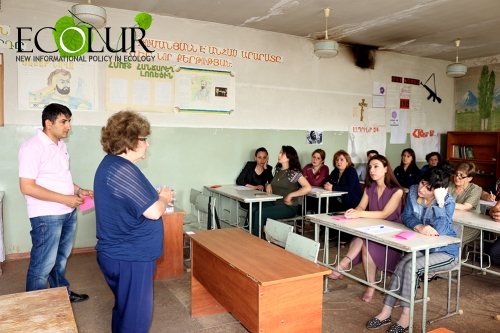

EcoLur
Akhtala and Shamlu towns are under the impact of Shamlukh copper mine owned by “Akhtala Ore Processing Combine” CJSC. “Ores are mined because of which the entire environment is silvery: you won’t find a place in Akhtala which won’t glitter because of metals. The entire environment must be cleaned. In the past, sprinkling trucks used to wash the streets and trees,” said the residents at the discussions held by EcoLur on “Be Aware and Demanding, Protect Your Interests and Rights in Armenian Processes of the EITI”.
The residents raised their demand to clean Akhtala from heavy metals and toxic substances.
The residents of Shamlugh residential area in Akhtala optimized community also complained about the pollution of the environment as a result of the operations of Akhtala Ore Processing Combine. “We are selling the health of our children at an unknown price. The health of our children is hugely undermined. What structure shall eventually assess the risks?...
It should be mentioned that for its negative impact on the environment “Akhtala Ore Processing Combine” CJSC pays environmental fees to the state budget as laid down in RA Law “On Expedient Use of Environmental Taxes Paid by Companies”. This money the state is directing to the combine-impacted communities in the form of subventions in case these communities have proposed environmental and healthcare projects. According to the First National EITI Report (2018), in 2016 “Akhtala Mining and Processing Enterprise” CJSC paid 1,208,058 AMD as environmental fees and 1,561,790 AMD in 2017. In 2016, Akhtala community was allotted a subvention of 4,588,000 AMD for environmental and healthcare project, while this figure for 2017 was 1,874,000 AMD. Out of funds allotted in 2016, 3,212,000 AMD was envisaged for covering Abovyan Street in Sarahart neighborhood in Akhtala with asphalt, 1,376,000 AMD for health measures, which are not detailed in the report.
In 2017, 416,000 AMD was allotted to Mets Ayrum residential area in optimized Akhtala for the organization of garbage collection, 1,192,000 AMD for the same purpose in Tchotchkan residential area and 266,000 AMD for the implementation of healthcare measures in Mets Ayrum residential area. Nahatak tailing dump of the combine is located in the area of these villages.
It is clear that the environmental projects implemented with the allotted funds haven’t mitigated the impact of the combine on the environment. On the other hand, the environmental fees themselves are very low and it is not possible to clean the environment from heavy metals and toxic substances with these funds or to prevent their spread in the environment, for these purpose the communities direct these funds for the solution to other problems in the community.
Akhtala residents also proposed:
1. to raise the awareness of the population about the environmental pollution and impact on the health conditioned with the operations of Akhtala Ore Processing Combine and through disseminating easily-understandable versions of the research on the health impact among the population,
2. To ensure the participation of the population representatives in the decision-making process on mine operations,
3. To ensure the cooperation between the combine and population and to ensure direct discussion of the matters arising between the combine administration and the population,
4. To allot 250,000 AMD out of 5 million AMD allotted by the combine to include meat in the diet of elementary schoolchildren in the optimized community.
In their turn, Shamlugh residents proposed,
1. To increase the rate of taxes paid by the company,
2. To carry out in-depth medical checkup and treatment of the residents by Health Ministry,
3. To regularly check the compliance of the operations of “Akhtala Ore Processing Combine” CJSC to the environmental standards,
4. To review the rate of fines for environmental damage and to make allocations based to what extent the residential area has suffered from the mine and the extent of the impact,
5. To assess the state of destroyed roads, and to obligate the combine to repair them.














This material has been prepared within “Mining-Impacted Communities – Full Participants in EITI Process'” project implemented by EcoLur with the USAID support within the frames of “Engaged Citizenry for Responsible Governance” project implemented by Transparency International Anticorruption Center.

This article is made possible by the generous support of the American People through the United States Agency for International Development (USAID). The contents of this article are the sole responsibility of the authors and do not necessarily reflect the views of USAID or the United States Government.
June 20, 2019 at 11:06
